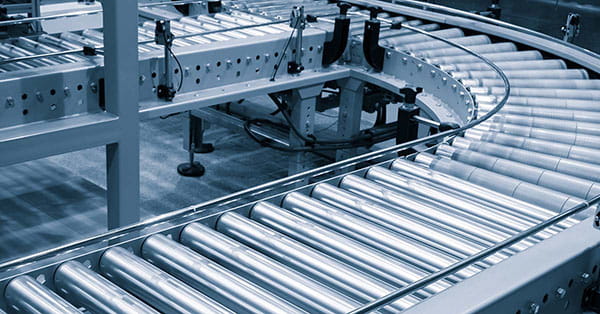South Carolina Conveyor Systems Supplier
AS/RS systems and conveyors can increase the efficiency of your warehouse, improve warehouse safety and substantially lower employee costs.
Conveyors can move both individual cartons and entire pallets within your facility, and they are an essential part of modern material handling design.
Conveyor systems can be grouped in three different categories for the vast majority of material handling configurations:
- Powered roller or belt conveyors (for package handling)
- Powered chain or roller conveyor systems (for pallet handling)
- Non-powered systems
Powered Package Handling Roller or Belt Conveyors
Powered belt or roller conveyors are often used for lighter weight pieces like cartons and packages.
Belts are mostly employed for moving packages along a line, while rollers are employed for amassing products in specific areas along the line.
Belt Conveyors
Used since the beginning of the 20th Century, conveyor belts are a staple of many material handling configurations. Less expensive than roller options and oftentimes better suited to specific functions like transporting lighter weight products, belt conveyors have a place in most material handling configurations.
Conveyor belts employ a long, looped belt that sits atop a series of non-powered rollers on a metal substructure called a slider belt. A motor drives a pulley that turns the belt and advances items down the conveyor line.
Belts are configured with a variety of surfaces and materials depending on the purpose and nature of the conveyor. For example, a conveyor belt surface could be un-ridged in areas where products need to glide off the line and may have a ridged surface on segments where items have to be advanced up gradients.
Roller Conveyors
While belt conveyors still have a place in most operations, newer roller conveyors offer a host of more useful benefits in many modern material handling uses.
Principal among these, roller configurations can allow for collection of objects on the line where belt configurations cannot. This is an important distinction because there are endless scenarios where products must decelerate and accumulate in material handling designs. Accumulation processes are often used when items must be temporarily halted before being forwarded to automated palletizers or sorters.
Some roller conveyor systems also have the ability to track objects on the line and apply zero pressure accumulation, meaning none of the products collecting on the line touch each other as they decelerate and come to a stop.
Roller systems feature a series of cylinder rollers that are usually powered in one of these ways:
- Line shaft conveyors: In a line shaft system, a long steel rod runs beneath the cylinders at a right angle to them and is attached to each cylinder with flexible O-rings. A motor turns the shaft and, accordingly, rotates the cylinders via the connected O-rings. Line shaft conveyors are the most inexpensive of all roller conveyors, but they also require the most repair because the connections between the rollers and the shaft tend to need adjustment and sometimes fail.
- Belt-driven roller conveyors: As you may expect, these systems are powered by a belt that lies underneath the roller surface. A motor powers the belt, which advances the roller cylinders.
- MDR conveyors: Motorized roller conveyors, sometimes called motor-driven roller (MDR) conveyors, are set up in segments where one cylinder from each section is driven by ’its own motor. That one powered roller is linked to the adjacent rollers in that segment by way of flexible O-rings and therefore rotates all the cylinders in the section. Motorized segments are positioned in succession to configure the conveyor line.
MDR systems are known for their energy efficiency because: a.) They generally are powered by 24-volt DC motors and b.) The electric motors are set up to engage only when an object is present on the rollers, and as a result they are inactive much of the time.
Although the cost of MDR conveyors is higher than belt drive and line shaft systems, power costs and service expenses are typically far lower than the other options mentioned. - Segmented belt conveyor: The concept of motor-driven roller systems ultimately begat the birth of segmented belt conveyors. Similar to motor-driven roller systems, segmented belts are powered independently and offer several of the same benefits of motor-driven rollers, including accumulation potential.
Powered Pallet Handling Conveyors
Powered pallet handling conveyors are frequently paired with AS/RS systems and automatic palletizers. Pallet handling conveyors can generally handle loads of up to two tons and proceed at a far slower rate than package-handling systems, many times at speeds as low as four pallets per minute.
Pallet handling conveyors come in two types: chain conveyors and roller conveyors.
- Pallet handling chain conveyor: Perhaps the most basic of all conveyors, pallets on a chain conveyor line are placed directly on two or more lengths of heavy-duty chain. Motors propel the chain segments, which consequently advance the pallets down the line.
- Pallet handling roller conveyor: Analogous to motor-driven roller conveyors, pallet handling roller conveyors use large cylinders and sturdy chains to connect the powered roller to the remaining rollers in a conveyor unit.
Non-Powered Conveyors
Roller or skatewheel conveyors are the conventional types of non-powered conveyors used in typical warehouse operations. These types of systems use inertia and gravity to advance smaller loads through warehouses, pick modules, automated sorters, workstations, loading docks and package-sorting areas.
Skatewheel systems comprise numerous individual wheels and need very little power to maintain the inertia of products as they advance along a conveyor line. On the whole, they propel items quicker than non-powered roller conveyors, and they have more adaptability when it comes to setup. Given that they’re separate wheels instead of a belt, they may be applied in curved sections of a conveyor system.
In general, non-powered roller configurations are less costly than skatewheel conveyor configurations. They’re frequently utilized for work-stations, pick modules and other sectors where it’s beneficial to have a flat surface to work on. Roller systems also slow products down that are coming from higher speed mechanisms like sorters so that employees can keep up with conveyor performance.
Non-powered skatewheel and roller systems have a significant disadvantage compared to powered systems: By employing gravity and inertia to move items, you lose the ability to directly manage the force applied to those materials. Put another way, you have minimal control of the inertia and speed of materials on your conveyor line.
Conveyor Companies Near Me
If you’d like a full analysis of conveyor system possibilities for your storage facility, distribution center or other material handling operation, speak with a professional at Carolina Handling.
-
-
Proudly serving
Charleston, North Charleston,
Mount Pleasant, Summerville,
Goose Creek, Bluffton,
Hilton Head, Beaufort, Port Royal,
Orangeburg, Santee, Manning,
Sumter, Columbia, Lexington,
Myrtle Beach, Florence, Manning,
Hampton, Walterboro,
and the entire State of South Carolina.
You May Also Like:
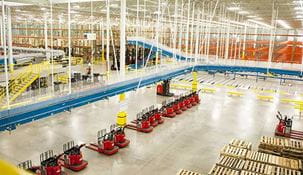
Automation
Carolina Handling can help you automate every aspect of your warehouse operation to increase efficiency.
Learn More
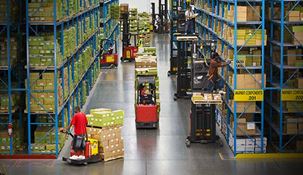
Optimization
Optimize everything in your warehouse to improve productivity and reduce operating costs.
Learn More
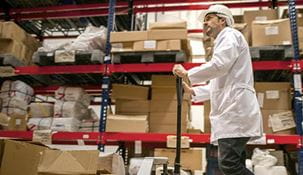
Warehouse Products
Looking for the right product for your operation? We have everything you need to do business in stock.
Learn More
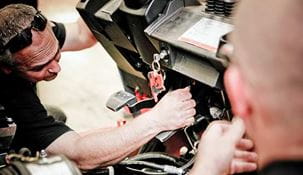
Service Maintenance
Providing superior lift truck service and maintenance for our customers is Carolina Handling's highest priority.
Learn More


